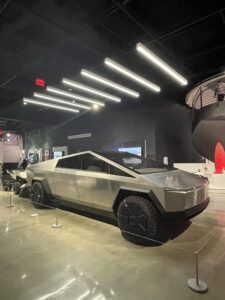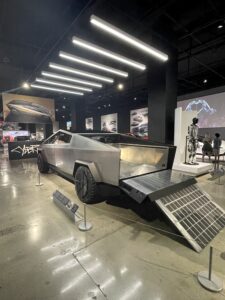The History of Tesla Cybertruck
In 2013, CEO Elon Musk set his sights on creating a revolutionary truck that would rival the Ford F-250, the Tesla CyberTruck. This ambitious truck project was estimated to take four or five years of development. Musk revealed his vision for a new consumer pickup truck two years later. He shared the vehicle had to be as large as a Ford F-150 and possess a “game-changing feature.”
During the Tesla Roadster and Tesla Semi unveiling, a photo of a “pickup truck that can carry a pickup truck” was displayed. Musk announced the truck prototype would be produced in 2019. After the release, Musk enticed the public with a teaser of a vehicle resembling a futuristic personnel carrier. Rumored to be called Model B, Tesla successfully trademarked “Cybrtrk.” In mid-2019, it was revealed that the towing capacity of the Cybertruck exceeded that of the Ford F-150.
Design Concept
Musk disclosed the design concept drew inspiration from the iconic submarine car, the Wet Nellie. The iconic submarine was in the movie “The Spy Who Loved Me.” Notably, Musk acquired the vehicle used in the film during an auction in 2013. As for the unveiling, Musk initially estimated it would take place around two or three months after July. The vehicle unveiled in November of the same year at the Tesla Design Studio in Los Angeles, next to SpaceX headquarters.
A captivating graffiti-theme logo featuring the word “Cybertruck,” presented the vehicle. A month later, the Tesla Cybertruck and Tesla Cyberquad appeared in rapper Travis Scott’s music video for “Gang Gang.” During the unveiling, Tesla claimed that the “Armor Glass” windows of the Cybertruck were virtually unbreakable. However, the windows shattered when a metal ball broke through. Musk explained that the initial damage occurred during a previous demonstration, where a sledgehammer cracked the base of the glass.
Design and Specifications
One of the standout features of the Cybertruck is its dynamic air suspension travel capability, which Musk aimed to improve for better off-road performance. The vehicle also boasts a self-leveling suspension, compensating for varying load weights. Standard in the Cybertruck is on-board power inverters, supplying 120 and 240-volt electricity. This allows for using power tools without a portable generator, and an air compressor powers pneumatic tools. Features included in all Tesla vehicles are the Tesla Autopilot and hardware for fully autonomous operation,
A bullet-resistant stainless-steel metal sheet composes the exterior of the vehicle. Musk announced that a solar roof option would be available, providing an additional 15 miles of range per day. In terms of size, the Tesla Cybertruck’s bed is comparable to that of a conventional pickup truck, measuring about 6 feet long. The truck’s side walls slope and feature an integral motorized roller shutter-style tonneau cover. The roller cover improves aerodynamics. This cover, known as “the vault,” also enhances security. LED light strips adorn each side of the truck. Additional storage space is available under the floor, behind the rear wheels, and 120- and 240-volt AC outlets are present. The cabin’s climate control accommodates camping and other outdoor activities. Notably, the prototype showcased a ramp extending from the tailgate to the ground, facilitating cargo loading.
 Design Inspiration
Design Inspiration
The Tesla Cybertruck’s design drew inspiration from “Blade Runner” and the Lotus Esprit, the iconic vehicle portrayed as a submarine in “The Spy Who Loved Me.” It is no surprise that Musk found inspiration in this legendary film. The design led to the creation of the Cybertruck’s unibody, referred to as the “exoskeleton.” This design choice is in passenger cars, providing ample space for the under-floor battery pack. The Cybertruck’s body panels are of 3mm (1/8 inch), 30x-series cold-rolled stainless steel. This prevents the body from being like traditional automobile parts. The material’s thickness allows it to bend along straight lines, resulting in a unique “low-poly” design reminiscent of origami. This material, also used on SpaceX’s Starship Rocket, ensures even stress distribution and maximizes interior volume.
Stainless steel composes the outer panels. This utilizes a Tesla-developed alloy for added strength. The prototype’s interior boasted a 17-inch center display, seating six for two bench seats and a fold-down center armrest. The front middle seat also served as a fold-down center armrest. The interior featured a race car-style steering yoke, a digital rear-view camera-based mirror, and a dashboard made from a composite material derived from “paper, wood-based fibers, natural wood pigments, and non-petroleum-based resins.” The rear seat folds to accommodate long cargo and extended from the vault into the cab.
Additional Features of the Tesla Cybertruck
In terms of storage space, the Cybertruck offers 100 cubic feet (2.8 m3), with a cargo area measuring 6.5 feet (2.0 m) long. The Cybertruck is perfect for off-roading adventures. This is due to a ground clearance of up to 16 inches, a 28-degree departure angle, and a 35-degree approach angle. Safety The Cybertruck’s design has come under fire from automotive safety groups such as the Australasian New Car Assessment Program and the Euro NCAP. These groups criticized the truck for failing to comply with pedestrian and cyclist safety standards, rendering it potentially illegal on the streets of Australia and the European Union. The rigidity of the “exoskeleton” exterior and the tall, flat front of the truck increases the risk and severity of leg injuries in the event of a collision.
